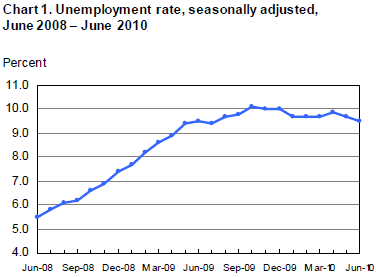Isn’t it time to come up with another way of measuring unemployment than the unemployment rate?
Today, the government said the unemployment rate fell to 9.5 percent. Great news? No. Although the unemployment rate dropped to the lowest level since July 2009, it fell because 652,000 people gave up on their job searches and left the labor force.
People who are no longer looking for work aren’t counted as unemployed, the Associated Press reported. But the problem with that rationale is obvious: they are unemployed.
So, what’s the real unemployment rate? About 16.5%, the Wall Street Journal says. But even that rate dropped, though not by much.
The effect of the recession on workers, however, is much more significant, according to a new poll from Pew Research. Fifty-five percent of those surveyed say they’ve been negatively affected by the recession; they have suffered a spell of unemployment, a cut in pay, a reduction in hours or have become involuntary part-time workers.
Sixty-two percent of people, however, believe their personal finances will get better.
“We’re heading in the right direction,” President Obama said this morning, shortly before leaving Washington for a vacation. It’s a common presidential tactic. If you want people to think things are looking up, just say they are.
At the start of the year in which that iconic ad ran, unemployment was only 1.5% lower than it is now, although it was much lower than the high of 10.8% in 1982. In Minnesota, the current unemployment rate is only .2 percent higher than it was in 1984.
The chart of the U.S. unemployment rate now, however — even with its statistical phoniness described above — doesn’t suggest that things are getting much better.

“It’s going to be a slow recovery for unemployment,” The Atlantic’s David Indiviglio wrote today in his analysis. That much was obvious months ago.
